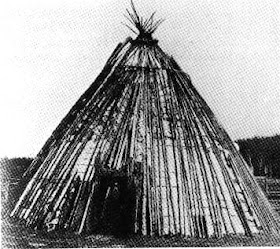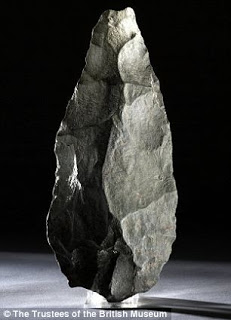The earliest evidence of probable offerings to supernatural powers was found in Drachenloch, in the Tamina Vally, in Switzerland.
Bear Bones had been placed there with some flesh still attached to the skulls, brains intact, and some leg bones, in a state as if to be eaten.
They are thought to have been offerings to appease the animal spirits, to thank them for a successful hunt, or to seek favor with the animal spirits for future hunts.
▼
Saturday, April 27, 2013
Wednesday, April 24, 2013
Hunting Magic of Primordial People
Paleolithic humans used magic to help in hunting animals.
The principal form of magic was mimetic.
A type of magic where paleolithic humans would imitate an animal they were hunting in order to connect to its spirit and ensure success in hunting it.
Paleolithic people also used sympathetic or homeopathic; a magic where an act upon an object representing the animal would literally have an effect on the animal itself.
Thus clay figures and drawings of animals that have been found, which were presumably to aid success in hunting.
A constant supply of game for the hunt was crucial, and fertility magic was preformed to ensure it.
This usually involved depicting a females with offspring.
Clay models of bison in couples and a bull following a cow have also been found in France, and at La Madeleine there is a drawing showing a doe with a fawn.
The principal form of magic was mimetic.
A type of magic where paleolithic humans would imitate an animal they were hunting in order to connect to its spirit and ensure success in hunting it.
Paleolithic people also used sympathetic or homeopathic; a magic where an act upon an object representing the animal would literally have an effect on the animal itself.
Thus clay figures and drawings of animals that have been found, which were presumably to aid success in hunting.
A constant supply of game for the hunt was crucial, and fertility magic was preformed to ensure it.
This usually involved depicting a females with offspring.
Clay models of bison in couples and a bull following a cow have also been found in France, and at La Madeleine there is a drawing showing a doe with a fawn.
Tuesday, April 23, 2013
Caves and Cave Art of Primordial People
To primitive humans, caves were sacred places.
People lived around or inside the entrance of a cave, but ventured deeper into the cave for religious or magical purposes.
Animal paintings on the walls of caves may have been primitive man's way of connecting with their spiritual qualities.
Boys were taken into the caves to be initiated as hunters.
A rite that probably involved a symbolic death and rebirth deep within a dimly lit, womb-like cave surrounded by animal images.
To early humans a cave symbolized the leaving of everyday reality.
As they went inside to find where their deeper nature-connected deities and went to honor the spirits of other animals.
Many early cave paintings, such as those of the Trois Frères cavern, in southern France, depict beings who are part-animal and part-human in form.
A bearded male figure, with ears of a bull, antlers and a horse's tail, may have represented either a divinity or a magician.
It is difficult to differentiate between images of human magicians and divine figures in Paleolithic art, as both appear to share this mixture of human and animal features.
The magician was an important member of the community and was probably considered a god in human form, with influence upon the gods and animal spirits.
People lived around or inside the entrance of a cave, but ventured deeper into the cave for religious or magical purposes.
Animal paintings on the walls of caves may have been primitive man's way of connecting with their spiritual qualities.
Boys were taken into the caves to be initiated as hunters.
A rite that probably involved a symbolic death and rebirth deep within a dimly lit, womb-like cave surrounded by animal images.
To early humans a cave symbolized the leaving of everyday reality.
As they went inside to find where their deeper nature-connected deities and went to honor the spirits of other animals.
Many early cave paintings, such as those of the Trois Frères cavern, in southern France, depict beings who are part-animal and part-human in form.
A bearded male figure, with ears of a bull, antlers and a horse's tail, may have represented either a divinity or a magician.
It is difficult to differentiate between images of human magicians and divine figures in Paleolithic art, as both appear to share this mixture of human and animal features.
The magician was an important member of the community and was probably considered a god in human form, with influence upon the gods and animal spirits.
Wednesday, April 17, 2013
Primordial Fire
The ability to make fire and harness its energy was a highly significant development, achieved by Homo erectus (around 1.6 million - 300,000 BCE), and gave fire important symbolic qualities.
The act of making fire represents the spark of imagination and creativity, and the energy of fire is in itself symbolic of power: harnessing and using nature to control other aspects of the natural world, bringing life-sustaining warmth, and frightening away threatening animals.
Fire enabled people to extend the day after dark, creating a social time around a campfire or hearth, sharing myths and stories.
At this early stage fire also became a symbol of trasformation through the process of cooking.
The act of making fire represents the spark of imagination and creativity, and the energy of fire is in itself symbolic of power: harnessing and using nature to control other aspects of the natural world, bringing life-sustaining warmth, and frightening away threatening animals.
Fire enabled people to extend the day after dark, creating a social time around a campfire or hearth, sharing myths and stories.
At this early stage fire also became a symbol of trasformation through the process of cooking.
Tuesday, April 16, 2013
Primordial Signs and Symbols
During the era of Australopithecus (the Australopithecus Africanus (from about 3.6 million BCE) to Homo Sapiens) humans began making tools, learning how to use and make fire, and construct houses.
All of the information we have of our early ancestors comes from archaeological evidence; such as cave paintings, artefacts, and traces of of possible ritual practices.
Evidence of the development of symbol and ritual comes mainly from the Paleolithic people who emerged about two million years ago.
They were mainly hunters, and much of their industry involved working with chipped stone.
At the time, our ancestors started developing language.
With the beginnings of language and the convenience of tools, man had more time to think and create.
This was the dawn of mythology and symbolism.
It meant that people were beginning to relate to concepts deeper than what they had in their daily lives.
It is easy to imagine that their relationship with nature, the seasons and weather, the animals they hunted, the birth of their children and the inevitability of death led them to ponder the events in their lives.
The primitive symbols of the cave, fire, the hand axe, and the representation of animal figures, may have served as foundation metaphors for the complex human mythologies that have subsequently evolved.
The symbols and rituals of primordial human beings may have served to align these people with the rhythms of their bodies, and nature; and to honor the forces influencing them.
All of the information we have of our early ancestors comes from archaeological evidence; such as cave paintings, artefacts, and traces of of possible ritual practices.
Evidence of the development of symbol and ritual comes mainly from the Paleolithic people who emerged about two million years ago.
They were mainly hunters, and much of their industry involved working with chipped stone.
At the time, our ancestors started developing language.
With the beginnings of language and the convenience of tools, man had more time to think and create.
This was the dawn of mythology and symbolism.
It is easy to imagine that their relationship with nature, the seasons and weather, the animals they hunted, the birth of their children and the inevitability of death led them to ponder the events in their lives.
The primitive symbols of the cave, fire, the hand axe, and the representation of animal figures, may have served as foundation metaphors for the complex human mythologies that have subsequently evolved.
The symbols and rituals of primordial human beings may have served to align these people with the rhythms of their bodies, and nature; and to honor the forces influencing them.
MORE ON PRIMORDIAL SIGNS AND SYMBOLS:
Sunday, April 14, 2013
Introduction to Signs and Symbols Part 2
A sign may be understood as something that stands for or points to something else in a literal way.
A sign conveys information about a curtain topic or idea.
While a symbol is meant to trigger a series of meanings or emotional responses.
As a sign, the word "tree" means a type of plant that has a woody structure, a trunk, branches, leaves, and roots.
While as a symbol it may represent the "tree of life" which links the everyday world and the notion of the spirit world.
Signs and symbols don't have exact meanings, since the same tree could be described in an infinite amount of ways, in different languages and in different cultures.
Signs and symbols derive their meanings from human interaction.
A sign conveys information about a curtain topic or idea.
While a symbol is meant to trigger a series of meanings or emotional responses.
As a sign, the word "tree" means a type of plant that has a woody structure, a trunk, branches, leaves, and roots.
While as a symbol it may represent the "tree of life" which links the everyday world and the notion of the spirit world.
Signs and symbols don't have exact meanings, since the same tree could be described in an infinite amount of ways, in different languages and in different cultures.
Signs and symbols derive their meanings from human interaction.
They change throughout different times, evolving as we do.
Friday, April 12, 2013
Introduction to Symbols Part 1
The word "symbol" is derived from the ancient Greek word symballein, meaning to throw together.
Its figurative use originated in the custom of breaking a clay tablet to mark the conclusion of a contract or agreement.
Each party in the agreement would be given a piece of the brocken tablet, so that when they reconvened the pieces could be put together like a jigsaw puzzle.
The broken pieces of the of the tablet, that identified the persons in the agreement, were known as symbola.
So a symbol then came to be known as something that represented something else.
Symbols also represented something missing or an invisible part that is needed in order to complete the whole meaning.
Whether consciously or unconsciously, symbols carry the sense of joining things together to create a whole greater than the sum of its parts, as shades of meaning accrue to produce a complex idea.
Its figurative use originated in the custom of breaking a clay tablet to mark the conclusion of a contract or agreement.
Each party in the agreement would be given a piece of the brocken tablet, so that when they reconvened the pieces could be put together like a jigsaw puzzle.
The broken pieces of the of the tablet, that identified the persons in the agreement, were known as symbola.
So a symbol then came to be known as something that represented something else.
Symbols also represented something missing or an invisible part that is needed in order to complete the whole meaning.
Whether consciously or unconsciously, symbols carry the sense of joining things together to create a whole greater than the sum of its parts, as shades of meaning accrue to produce a complex idea.
















































